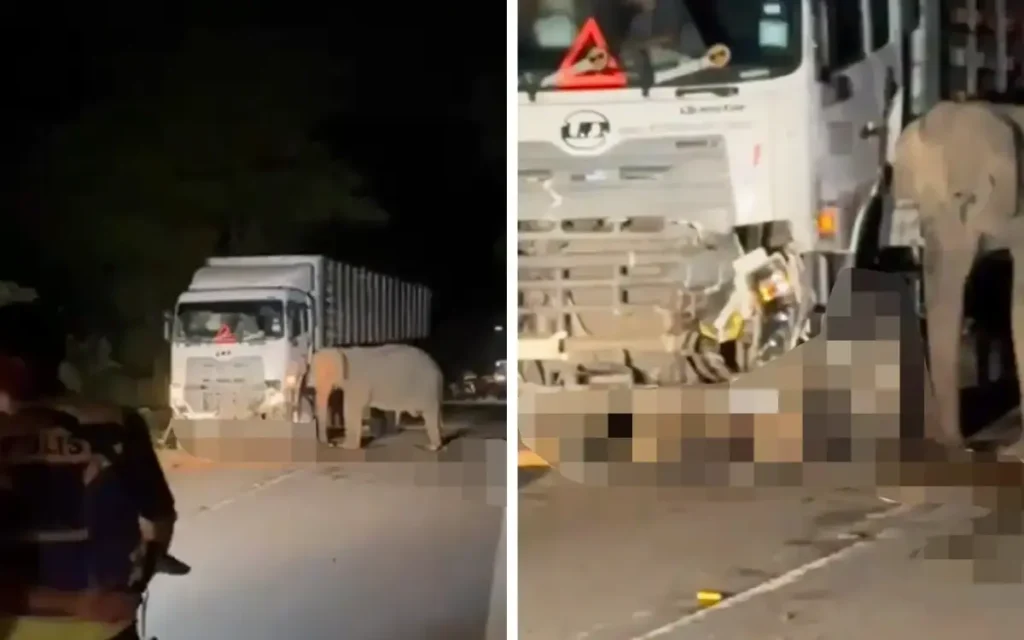What To Do When You See An Elephant While Driving
Malaysia’s lush tropical forests are home to extraordinary wildlife, including the endangered Asian elephant. As highways are built through these natural habitats, drivers must remember that they do not rule alone; wild animals also share these paths.
Coexistence isn’t a choice, it’s a responsibility.

This Mother’s Day, many Malaysians were reminded not only of their mothers, but also of Mother Nature, after a heartbreaking tragedy on the Gerik–Jeli Highway that claimed the life of a baby elephant.
As its lifeless body laid trapped beneath a lorry, its mother stood nearby, wailing, helpless. The haunting scene struck many citizens online. This tragedy, although painful, is not one in isolation.
A total of 2,361 wild animals were reported to have been killed by vehicles since 2020.
However, it’s not just the animals at risk — drivers, too, face danger when collisions occur with wildlife. These encounters can lead to severe injuries, fatalities and vehicle damage.
Together, we can build awareness on what to do when you see an elephant while driving on a highway to avoid such further tragedies.
What To Do When You See An Elephant On The Road?
1. Maintain a Safe Distance
Elephants are wild animals, they may see your car as a threat. Stay at least 30 – 50 metres away from the elephant, to let them know you’re not out to harm them.
Besides that, never exit your vehicle to scare or try to get the elephant to get out of your way.
2. Stay Calm and Quiet
It is best to stay in your car and not make any unnecessary noises such as honking, shouting or revving up your engine.
Elephants are sensitive to loud noises and may become agitated or defensive and this can lead to them seeing you as a threat.
3. No Flash Photography or Video
If you’re recording, turn off your flash. Bright lights can stress elephants, especially young calves.
Avoid any distractions that could provoke the mother elephant, as they are highly protective of their young.
4. Night Driving Tips
Did you know that 81% of elephant crossings occur at night?
Drivers are urged to use low-beam headlights in poor visibility to see what’s in front of them.
Take note of elephant crossing areas around the country and be mindful of them by driving slowly on a dark highway.
5. Wait Patiently
Elephants often travel in herds, it may take time for every single one of them to cross. Be patient and never try to rush them to cross the highway.
Why Did The Elephant Cross The Road?
And no, this isn’t a one-liner dad joke — it’s a serious issue.
As highways and roads continue to expand, elephant habitats are divided. Roads are crucial in connecting the east and west of the peninsula, but they also fragment elephant habitats, forcing them to cross roads to find resources such as food and water and often, to connect with lost members of their herd.
This study finds that Asian elephants in Malaysia are even drawn to roadsides due to the open spaces left by logging and the abundance of grass and vegetation growing along the verges.
Elephant Crossing Hotspots
Here are the most popular highways and roads that often have Elephant sightings:
- Gerik–Jeli Highway (Belum–Temengor Forest, Perak)
- Roads near Kenyir Lake, Terengganu
- Central Spine Road, Pahang (Forest regions)
- Endau–Rompin Forest Reserve, Johor

How Is Malaysia’s Federal & State Government Playing A Role?
- Regular patrols and monitoring at elephant conflict hotspots along over 100km of winding, low-visibility sections of the East-West highway in Malaysia
- Installation of streetlights at 16 high-risk locations
- 7 new locations for wildlife crossing warning signs
- Existing wildlife corridors and more are to be built in the near future
As much as authorities are taking action, reducing human-elephant conflict is a responsibility for all. This teamwork requires support from plantation owners, local communities and road users.
What Can You Do To Make A Difference?
- Report disturbances by wild animals
- Share this post to create awareness among your social groups.
- Donate to organisations and bodies that help preserve wildlife, such as PERHILITAN and WWF Malaysia
Driving On A Highway? Get Protected With Etiqa Motor Insurance
Elephant accidents on Malaysian highways happen frequently, and it’s honestly heart-breaking. These unexpected encounters with wildlife, especially at night, can be dangerous for both the animals and the people in the car.
The best we can do is educate ourselves on what to do when encountering an elephant on a highway, and get the right protection for our vehicle and lives.
With Etiqa Car Insurance, you can add the windscreen coverage add-on in case of an accident and the OTO360 personal accident add-on which covers you and your passenger(s) in case of death or permanent disability due to a car accident.
Learn more about the different types of car insurance add-ons available here.
The information contained in this blog is provided for informational purposes only, and should not be construed as advice on any matter. Etiqa accepts no responsibility for loss which may arise from reliance on information contained in the article. This information is correct as of 21st May 2025.
